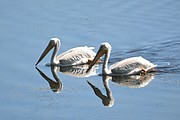The majestic white pelican
“And to lose the chance to see a file of pelicans winging their way homeward across the crimson afterglow of the sunset, or a myriad terns flashing in the bright light of midday as they hover in a shifting maze above the beach — why, the loss is like the loss of a gallery of the masterpieces of the artists of old time”
— Theodore Roosevelt
On a sight-seeing trip to Boundary/Smith Creek Wildlife Management Area and a drive along the west road I had the good fortune to see several flocks of migrating American white pelicans.
One of the largest North American birds with a wing-span up to 8 feet, the American white pelican is majestic in the air. The birds soar with incredible steadiness on broad, white-and-black wings. Their large heads and huge, heavy bills give them a prehistoric look.
On the water they dip their pouched bills to scoop up fish, or tip up like an oversized dabbling duck. Sometimes a group of pelicans work together to herd fish into the shallows for easy feeding. They are usually found on inland lakes in summer and near coastlines in winter.
The American white pelican is a huge water-bird with very broad wings, a long neck, and a massive bill that gives the head a unique, long shape. They have thick bodies, short legs, and short, square tails. During the breeding season, adults grow an unusual projection or horn on the upper mandible near the tip of the bill.
They are snowy white with black flight feathers visible only when the wings are spread. A small patch of ornamental feathers on the chest can become yellow in spring. The bill and legs are yellow-orange. Immatures are mostly white as well, but the head, neck, and back are variably dusky.
The American white pelican is dependent on wetlands for its survival. It nests on islands in freshwater and saline lakes, foraging in shallow waters up to 30 miles or more away. It uses similar foraging sites during migration to its largely coastal wintering sites. Preferred winter habitats are shallow bays, inlets, and estuaries containing suitable prey and loafing sites; it also can be seen on manmade ponds and lagoons. They nest in colonies. Their voice is usually silent, with grunts or croaks on nesting grounds.
The American white pelican is seasonally monogamous, pairing quickly after arrival at breeding sites. Courtship consists of circular flights over the nesting site, often with other individuals, and a variety of displays on the ground, including strutting, bowing, and head swaying. Sub-colonies form and grow as individuals are attracted and stimulated by the breeding activities of their neighbors.
The nest is merely a shallow depression, the rim often barely sufficient to keep eggs and chicks from rolling out. Two eggs are laid; incubation is by both parents equally, in two-day shifts, and lasts about 30 days. The young are born naked and blind, but their eyes open within a day. Parents regurgitate food for the young, onto the ground or their feet at first; thereafter the parents regurgitate the food to their own bill tip, then only within their pouch, and finally only into their own throat, whence the young remove it.
The first-hatched chick usually harasses its younger sibling until the latter dies of starvation. The parents alternate between brooding and foraging, switching daily, for about 17 to 25 days, after which the surviving young begin leaving the nests and forming creches (day nurseries) while both parents forage. Initially, the young return to their nests from the creches to eat and to be brooded at night, but as they get older they become less attached to the nest. The young take their first flights at about 9 to 10 weeks of age and leave the colony soon thereafter.
Like all pelicans, the American white pelican is primarily a fish eater. Its usual prey species are small schooling fish, but it also eats some bottom feeders; within the preferred size range, it is non-selective, taking prey purely on the basis of availability. It also takes salamanders and crayfish opportunistically.
The species often uses
a characteristic group feeding strategy wherein a flock will form a circle or semi-circle and, using coordinated bill dipping and wing beating, drive prey toward shore where it is more easily caught, scooping them into their pouches. They also forage individually but with less success; foraging behavior tends to shift toward cooperation when prey aggregations are located. It commonly forages at night during the breeding season, using tactile means of locating prey; daytime foraging is probably more visual.
White pelicans never plunge-dive like the brown pelicans. Daily food intake of breeding adults may reach 40 percent of body mass. White Pelicans often steal prey from one another and from other species, especially diving birds in deeper waters.
Get out and enjoy the wildlife of Boundary County!!



